Parks and Recreational Spaces
Ample availability and access to safe, clean, and green open parks and recreational spaces that appeal to interests and activities across generations have been found to significantly improve health and wellbeing.[1] Cities with ample green space have been found to have happier and more productive citizens, with less community demand for health services.[2] There are four pathways in which green space can improve community health and well-being: (1) reduces exposure to air pollutants; (2) encourages physical activity (3) stress compensation (4) and fosters greater social cohesion.[3]
Green space has been found to help alleviate stress. Furthermore, increasing physical activity amongst community members, by way of access to green space, leads to increased physical activity and better health. A 2016 study published by the Journal of American Medicine Association found that “greening” neighborhoods (planting new grass and trees, parks, trash maintenance) decreases feelings of depression in the community and empowers community members. In addition, Green spaces increase social connection which in turn increases the social capital (trust, social participation/connection) in a community. Increased social capital helps foster a sense of belonging and empowerment.[4] Science examining the positive effects of availability and access to green space must lead the way in cities investing in sustainable green infrastructure. This infrastructure not only helps improve the physical aesthetic of communities but provides positive, health-promoting experiences for the greater community.[5]
Many basebuilding organizers recognize the importance of green spaces and are working towards their creation and access. Their work has included initiatives such as installing community gardens, creating greener pathways for transportation and exercise, addressing pollution and contamination of community spaces, advocating for protection of natural lands, and establishing bicycle cooperatives.
DISPARITIES AND STATISTICS
Race and Ethnicity:
A 2017 study found that communities of color, specifically Black, Hispanic, and Asian communities, were found to have less green space, both in the form of parks as well as overall landscaping. Furthermore, the proportion of greenspace in communities of color, as opposed to white communities, has trended downwards since 2001.[6]
Recent studies from the Univ. of California, Los Angeles found that low-income communities of color are exposed to more pollutants that damage green space, contain parks and facilities that are not maintained, and overall suffer from a lack of funding in park programming.[7]
Socioeconomic:
A study released in 2019 by researchers at the University of British Columbia examined 10 major metros in the United States and documented access to parks and greenspace. Low-income communities were found to disproportionately have less access to parks and green space than high-income communities.[8]
There are wide-ranging disparities between low-income communities and areas that are more affluent in both the quantity and quality of park spaces. According to Environmental Health Sciences professor Michael Jerrett, “People living in low-income communities aren’t getting sufficient access to this health-promoting resource, and when they do have access, the area tends to be more polluted, the park facilities are not as well-maintained, and there is less park programming and less energy going into the programs offered.[9]






















